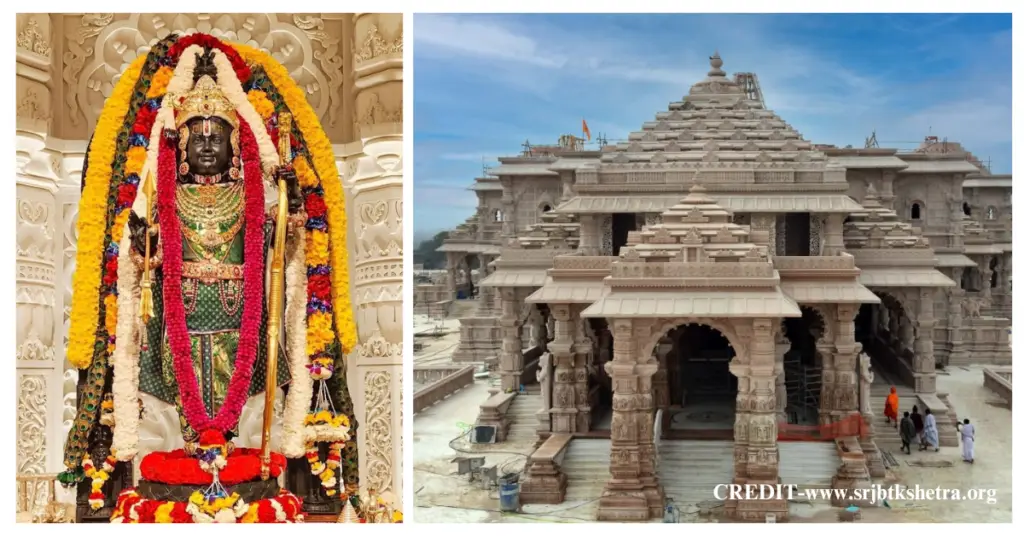You can now find the best Tourist Places in Ayodhya with the help of our ultimate tourist travel guide. Ensure to visit the temples, the tranquil ghats, off-the-beaten-path attractions, and any additional trips that present Ayodhya’s rich culture and heritage—ideal for both the devotees and the lovers of history.
Regarding pilgrimage and historical sites, Ayodhya is one of the most visited places in the country. Also called the Ram Mandir, Ayodhya is where people come and go for pilgrims. Be it the people looking for spirituality, exploring ancient buildings, or willing to embrace the culture, Ayodhya is a place worth remembering for ages.
Table of Contents
Overview of Ayodhya’s Cultural and Historical Significance
Ayodhya is not merely a city; it is like one has entered a moving legend. This place is the fount of belief and has temples, ghats, and other historical features that illustrate the Hindu way of life. The history of Aydohya is such that in the epic of Ramayana, Aydohya was the capital of Lord Ram, and because of this, this place has become a holy place and an area of interest. Every nook and cranny of Ayodhya has a tale to tell, and every trip appears as a new narrative unfolding.
Must Vist Tourist Places in Ayodhya
Here are the must-visit Tourist Places in Ayodhya
Ram Janmabhoomi Temple

Ram Janmabhoomi Temple is the one placement that is a must-see. It is said to be the exact location where Lord Ram was born. Being here, one can experience the aura of faith amassed for centuries. The temple’s design draws a lot from ancient designs. However, it has a modern touch and style, marrying history with magnificence.
Hanuman Garhi Temple

Located atop a hill, Hanuman Garhi Temple is an undertaking in the real sense. The temple entrance resembles the mouth of a cave, signifying the power and safeguards provided by Lord Hanuman. The better part of this climb involves walking up a few stairs, and Ayodhya’s boastful, breathtaking views can be spotted. For all those devotees who have faith in Lord Hanuman, it is believed that this temple provides them with the willpower and bravery to carry on with their lives.
Kanak Bhavan Temple

Kanak Bhavan is like Ayodhya’s, ‘sone ka mandir’. Which means the Golden Temple. It houses the golden idols of Lord Rama and his wife Sita, so it glows and twinkles, whether day or night. The ornate temple and its soothing ambience make it a place to sit for hours, enjoying the peace.
Sita Ki Rasoi

To glimpse the old customs, you can head to Sita Ki Rasoi, meaning “Sita’s Kitchen.” This small but beautiful temple is believed to be the place where Sita prepared meals for her kin. It sounds plain, yet being in this place, one understands how history had different lifestyles centuries ago. It is as if stepping into an old house makes you feel in touch with the days of the Ramayana.
Guptar Ghat: Scenic Riverfront

Guptar Ghat by the Saryu River is the best spot if you’d like to relax and absorb the calm beauty of Ayodhya. Legend says that Lord Ram took his last journey towards heaven from this place. It is a peaceful and maybe even spiritual place—ideal for some contemplation or simply gazing at the flowing waters of the river.
Ram Ki Paidi: A Serene Spot Along Saryu River

Ram Ki Paidi is a newly built site in Ayodhya, comprising broad stairs descending to the river and cleverly crafted kiosks. The glow of dawn, dusk, or even the calm water is almost poetic on this site. If visiting the place during a festive period, one would enjoy the colourful display of life along the river, especially the dhobi ghat.
Hidden Gems in Ayodhya
Military Temple

This shrine might be familiar to some, but it merits a slight change in course. The military temple is one such shrine that has a long history and is, therefore, often overlooked. A bonus is that the structure is quite interesting, too!
Tulsi Udyan Garden

Should you wish to stretch your legs away from the rigors of temple tours, Tulsi Udyan comes in handy. As the name suggests, the park is named after the poet-saint Tulsidas and provides respite from the hustles and bustles, filled with ample greenery and a calm atmosphere. Carry a book, sit on a bench, and drink in the Ayodhya peace.
Raja Mandir: Traditional and Cultural Hub

The Raja Mandir embodies rich history and spirituality. Visiting during a festival is the best way to see it in action—the energy is electric, and the temples come alive with customs. It’s a true picture of the culture of Ayodhya.
Best Time to Visit Ayodhya
Aydohya is best experienced from October to March when favorable weather and celebrations peak. When the ghats look spectacular with thousands of mud lamps, Diwali will be a memory that clings to you forever. If you are looking for a complete cultural experience, then prepare your visits around festivals like Ram Navami so that your trip will be filled with fun and entertainment.
Festivals in Ayodhya

Diwali here is unique—the city is full of lights, celebrations, and festivities everywhere, whether in a temple or a ghat. If you are around during Ram Navami, be ready to witness Ayodhya bursting with energy as the devotees revel in the celebrations marking Lord Ram’s birth. There is no other way to explain this, but being present in Ayodhya during any festivity is experiencing its heart, full of colours and without filters.
Final Thought
Maps do not do justice to Ayodhya, as it’s an experience in all proportions. The devotion, history, and aesthetic beauty that Ayodhya dangles with are sure to offer a journey that will never be forgotten. So, it won’t matter if you are travelling alone, with family, or undergoing a pilgrimage; the resorting kind-hearted aura of Ayodhya will embrace you dearly.

